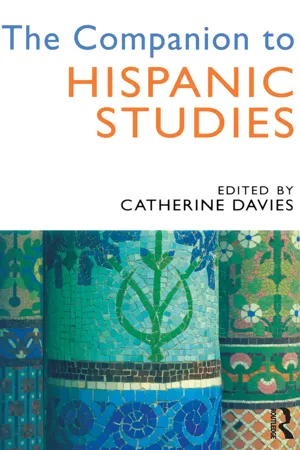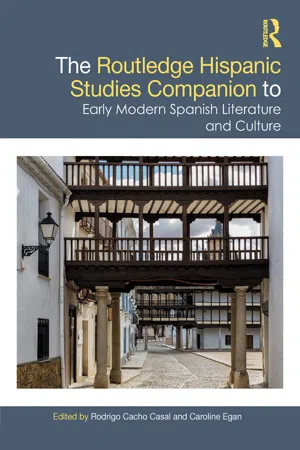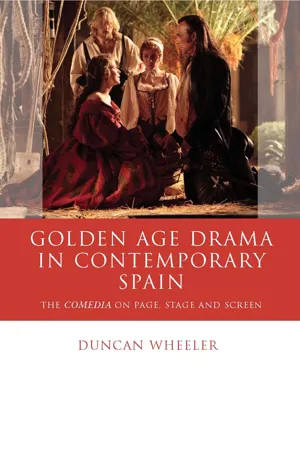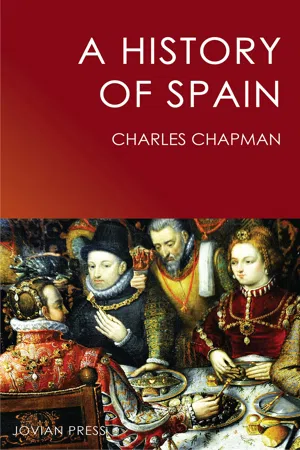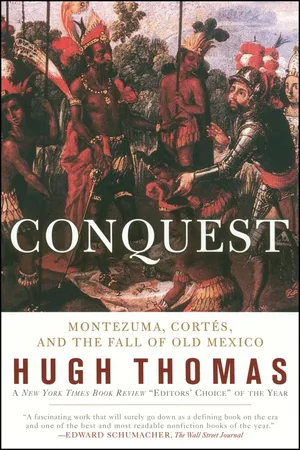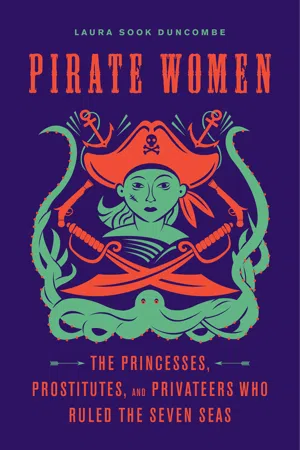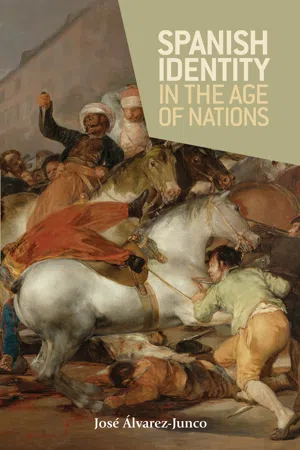History
Golden Age of Spain
The Golden Age of Spain refers to a period of flourishing in arts, literature, and exploration during the 16th and 17th centuries. It was characterized by the expansion of the Spanish Empire, the influence of prominent figures like Miguel de Cervantes and El Greco, and the development of Spanish Baroque art and architecture. This era marked Spain's cultural and political zenith.
Written by Perlego with AI-assistance
Related key terms
7 Key excerpts on "Golden Age of Spain"
- eBook - ePub
- Catherine Davies(Author)
- 2014(Publication Date)
- Routledge(Publisher)
3 Golden Age Studies: Spain and Spanish America in the sixteenth and seventeenth centuries Terence O'ReillyWhat are the challenges facing Golden Age Studies? First, a large number of the texts we need in order to form a clear view of this period remain unstudied. Many survive in printed form, but have not been examined closely in modern times; many more are still in manuscript; most have yet to be reproduced in trustworthy critical editions. And secondly, interpretation of the texts we do know has been bedevilled by modern controversies about three events that shaped the Golden Age: (1) the unification of the Iberian kingdoms around Castile, (2) the conquest and colonisation of the New World, and (3) resistance within Spain to certain aspects of the European Renaissance and Reformation. At the time of the Spanish Civil War and in its aftermath, these events were viewed positively, on the whole, by Franco's Nationalists, who found in them models to imitate, but negatively by Republicans, for whom they signified an erosion of freedom, Strange as it may seem, both sides sought in the Golden Age the origins of the conflict in which they were involved. But since the death of Franco the situation has changed. The task of editing texts, known and unknown, has been energised by a new generation of scholars. In a stream of studies, both historical and literary, many of our received notions about the period have been rethought. These studies have also underlined a basic truth: the literature of the Golden Age is informed by a mentality very different from our own. To read it with understanding, therefore, we must be sensitive to its otherness, otherwise we shall find in it no more than a reflection of our own concerns.Unity and Diversity
The Golden Age witnessed the ascendancy of Castile, especially in the century before 1580 (see Chapter 2 ), when the medieval kingdoms of Iberia came together as a political unit, namely la monarquía española - Rodrigo Cacho Casal, Caroline Egan, Rodrigo Cacho Casal, Caroline Egan, Rodrigo Cacho Casal, Caroline Egan(Authors)
- 2022(Publication Date)
- Routledge(Publisher)
In spite of its fortune, the rubric ‘Spanish Golden Age’ is problematic for at least two reasons; first, because it establishes a historic, artistic, and literary ranking that cannot withstand rigorous academic scrutiny. It purports the fiction that some eras are superior to others, more accomplished, advocating the idea that history is a long competition between winners and losers, creating a false sense of atemporal and universal values existing beyond specific cultural, social, political, and economic frames of reference. Second, such values are in fact highly subjective, and, inevitably, each historic period tends to place its own ‘Golden Age’ in a different moment in time. For instance, the Spaniards of the sixteenth and seventeenth centuries were quite unanimous in believing that this was to be identified with the reign of the Catholic Monarchs. Gonzalo Fernández de Oviedo (1974, vol. 2: 467) stated his unquestionable preference for the times of Queen Isabella: ‘aquel tiempo fue áureo e de justicia’ [that was a golden time and of justice], and a similar idea can also be found in Martín González de Cellorigo (1991: 95): ‘Nunca nuestra España en todas las cosas tuvo más alto grado de perfección’ [Never did our Spain reach a higher grade of perfection in all things].Arising from these considerations, the Golden Age label imposes a rhetoric of rise and fall, a pseudo-biological reading of history that organizes time in separate compartments that embody symbolic stages of evolution (childhood, young age, maturity, decrepitude …). If the Golden Age is considered the peak of the evolutionary scale, this is inevitably destined to collapse with time. This is an extremely antiquated way of conceiving history, one that was actually current in early modern Spain (Burke 1976). Nebrija’s theories on language and political power, discussed previously, rest on the conviction that empires, like all living creatures, evolve until they decline and perish. The greatness of Rome and Latin is unquestionable, and yet, they both shared the same fate: ‘junta mente començaron, crecieron i florecieron i, después, junta fue la caída de entrambos’ [they began together, they grew and flourished, and, afterwards, they fell together]. Spain may have taken Rome’s place, and yet this empire too is inevitably bound to collapse with time, as his words gloomily anticipate: ‘por estar ia nuestra lengua tanto en la cumbre, que más se puede temer el decendimiento della que esperar la subida’ [since our language has reached its peak, one should be more wary of its decline than hopeful of its rise] (Nebrija 2011: 3, 9).- eBook - ePub
Golden Age Drama in Contemporary Spain
The Comedia on Page, Stage and Screen
- Duncan Wheeler(Author)
- 2012(Publication Date)
- University of Wales Press(Publisher)
Chapter OneThe performance history of Golden Age drama in Spain (1939–2009)
_________________Following Franco’s victory in 1939, the legacy of the Civil War was felt in all aspects of Spanish life; the performance of Golden Age drama was no exception. Commentators have, traditionally, tended to direct more attention towards theatre produced by the Republicans than the Nationalists during the conflict. This is mainly because the former were more inventive in their theatrical endeavours and also because Madrid and Barcelona, the principal loci of theatrical activity, remained Republican strongholds until near the end of the war (Oliva, 2002a, p. 118). However, Golden Age works were performed by both sides. On the Republican front, Cervantes proved particularly popular; Alberti staged Numancia , and there were various productions of the entremeses [short plays] adapted to fit the contemporary context. There were also representations of Lope’s Fuente Ovejuna .1While Republican forces looked to adapt Golden Age works to fit the needs of the present, Nationalist forces saw the need for the present to be rooted in the past. Franco had already taken to comparing himself to the great Castilian rulers of the past, and as early as February 1938 he had adopted the imperial crown and shield of Charles V as the arms of state (Preston, 1995, p. 324). It was felt that Spain had lost its way and had, in many respects, ceased to be ‘Spanish’ since the seventeenth century.2 Golden Age authors were seen to represent an eternal Spain that the Nationalist side would reawaken. It is from this conception that José María Salaverria’s daydream emerges:Yo imagino a Garcilaso de la Vega ciñéndose apresuradamente la espada para correr a ponerse a las órdenes de Franco, como hiciera otrora con la persona del emperador Carlos V... En cuanto a Cervantes, sin duda posible se vendría con nosotros, y aunque con la mano estropeada, pediría un puesto entre nuestros soldados, porque él se enorgullecía, más que de nada, de haber sido un soldado leal... Tampoco vacilaría mucho Lope de Vega, aquel que se embarcó de voluntario en la Gran Armada; ni menos aún Calderón de la Barca, que fue soldado en Flandes y conservó siempre en su larga vida una nostálgica veneración por la gente militar. (1938) - eBook - ePub
- Charles Chapman(Author)
- 2017(Publication Date)
- Jovian Press(Publisher)
CHAPTER XXXTHE GOLDEN AGE: LITERATURE AND ART, 1516-1700
~T HEGENERAL CONDITIONS AFFECTING LITERATURE and art in thesiglo de orohave already been alluded to in the preceding chapter. The influence of Humanism and the impulse of the Renaissance were more directly felt in polite literature than in didactic and scientific works. Furthermore, this type of literature was more easily understood by people at large than the more special studies, and it is not surprising that Spain’s intellectual greatness should have been appreciated by the majority of the educated classes in terms of poetry, the novel, and the drama, together with the manifestations of the age in the fine arts. The very men who contributed works of a scientific character could not resist the appeal ofbelles lettres, and wrote books which not infrequently demonstrated their double right to homage. Knowledge of Latin, Greek, and various modern languages, especially Italian and French, was more or less general among the educated classes, giving an opportunity for the satisfaction of one’s wishes to delve into a varied literature, and opening the way to foreign influences upon Castilian work. The day of French influence seemed for a time to have passed, however (although it returned with the decline in the later seventeenth century); rather, a current against it had set in. The effect of the other three languages was so great, however, that Castilian temporarily lost some of its prestige, which passed over especially to Latin and Italian. Most works of an erudite character now appeared in Latin, and that language was the official tongue of most of the courses in the universities. The church, too, lent its weight to Latin.Nevertheless, Castilian was at no time in real danger. Anything intended for popular consumption found its way into Castilian, and not a few notable scientific works employed that language. Save for a few inefficacious attempts of the Humanists to use Latin, the field of polite literature was captured wholly by the native tongue. This victory for national sentiment carried with it an exuberant outburst of productivity which affected all classes. Prior to this time the clergy had provided almost the only representatives to win fame in - eBook - ePub
Conquest
Cortes, Montezuma, and the Fall of Old Mexico
- Hugh Thomas(Author)
- 2013(Publication Date)
- Simon & Schuster(Publisher)
32 Yet before the discovery of America, the gold of Europe itself mostly came from West Africa: the Upper Volta, the Upper Niger, and the Senegal rivers.The pursuit of new sources of this metal became an obsession. For riches, in the luminous words of Huizinga, had not yet acquired “the spectral impalpability which capitalism, founded in credit, would give later: what haunt[ed] the imagination was still the tangible, yellow gold”.33 Columbus thought that a man with gold could do what he liked in the world: “He can succeed in bringing souls to paradise.”34 Before his first voyage, he had even promised the sailors of Palos that, if they would only follow him, they “would all have houses with tiles of gold”.35*The Spain of Ferdinand and Isabel seemed to later generations to have been a golden age in a political sense. “We have discovered that the new state [which we are seeking] is nothing other than the Spanish state of the Catholic kings,” wrote a Carlist politician in the 1930s.36 The legend began at the time. The phrase “the golden years” was coined in 1495 by the playwright Juan del Encina.In some ways, this identification of the reign of Ferdinand and Isabel with the picture of Spain at its zenith is true. Aragon (with Catalonia) and Castile were brought together for the first time. The union was a conscious work of art in true Renaissance style, by the majestic Queen Isabel and her prudent husband, Ferdinand. Their symbol, the yoke or knot of Ferdinand, and the arrows of Isabel, with the motto, “Tanto Monta” , literally “Each as good as the other”, expressed the nature of the new association (though Castile was always to be the politically dominant partner).37 The victory over Granada had certainly been a triumph. Spain, hitherto merely a geographical expression, genuinely came into being, and not just in the minds of the conquistadors. For good or evil, Jewish and Moorish Spain ceased to exist as separate sources of loyalty. Noblemen were obliged to see the benefits as well as the responsibilities of the sovereign state: a consummation symbolised by the Crown’s seizure of the masterships of the overbearing knightly orders of Santiago, Alcántara and Calatrava. The government’s finances were reinvigorated. A monetary reform was carried through in 1497. The creation of the Holy Brotherhood in 1476 gave Castile the beginnings of a police. A supreme tribunal was established in Valladolid. The Crown was henceforth usually (rather than, as theretofore, sporadically) represented in large cities by a corregidor - eBook - ePub
Pirate Women
The Princesses, Prostitutes, and Privateers Who Ruled the Seven Seas
- Laura Sook Duncombe(Author)
- 2017(Publication Date)
- Chicago Review Press(Publisher)
6The Golden Age
T HE JOLLY ROGER . The fearsome, long-bearded pirate. The sun-soaked days and balmy Caribbean nights. Many of the images that have become synonymous with the word pirate originate in the Golden Age of piracy. This era spawned more legendary pirates and epic stories than almost all the other eras combined. Ask people to share a fact about piracy and, if they know one, chances are it will pertain to the Golden Age.For something talked about so often, the Golden Age of piracy is surprisingly difficult to define. Just placing a time limit on the Golden Age is tricky. Some historians clock it from the 1650s to the 1730s, while others claim only a fraction of that time. Professor Marcus Rediker uses a framework for the Golden Age as 1716 to 1726—a mere ten years—and historian Angus Konstam provides one of the shortest definitions: eight years, 1714 to 1722. Where the line gets drawn depends on a number of factors: whether the buccaneer period is included, which execution actually marks the last great pirate to be hanged, and so on. While all definitions have merit, a generous, wider definition gives the reader the opportunity for a clearer understanding of how the Golden Age came to be and how it evolved.Three major movements or periods define the Golden Age: the buccaneer period from 1650s to 1680s, the Pirate Round period from the 1690s to the 1700s, and the post–War of the Spanish Succession period from 1713 to the 1720s. That last period is often broken off by itself and called the Golden Age, as seen in Rediker’s and Konstam’s definitions, while the first two never stand alone as the Golden Age. The first two periods are like rough drafts to the Golden Age’s final copy—during these periods the politics and tactics of the Golden Age were developing and changing. Without these periods for context, the Golden Age would appear to have sprung fully formed out of nowhere, like Athena from Zeus’s head. While it is true that every age evolves from the age before it, and it’s fair to say that the Golden Age evolved out of, say, ancient Mediterranean piracy, the proximity in both time and place to the post–War of the Spanish Succession era render the buccaneer and Pirate Round periods especially influential to the development of “true” Golden Age piracy. For that reason, they are included in this definition of the Golden Age. - eBook - ePub
- José Álvarez-Junco(Author)
- 2013(Publication Date)
- Manchester University Press(Publisher)
For the educated élites, this identity was linked to the exploits, somewhat embellished by historians, of the collective entity known as ‘Spain’. Outstanding among these were the achievements, both political and cultural, of the Siglo de Oro, the Golden Age. Among the populace, however, it is probable that their loyalty was first and foremost to the local community and, in global political terms, was related almost exclusively to the monarchy, and in particular to the successes and failures of the royal armies. Religion aside, the monarchy seems to have been the focal point of the anti-French mobilisations of 1808. Documents indicative of the sentiments prevailing during the uprising certainly maintained the king-nation duality, but invocations of the former are far more frequent than those of the latter. If we are to believe these texts, those involved in the uprising undoubtedly felt themselves to be Spanish, but what they worshipped was not an abstract idea but an actual person, Fernando, a sacrosanct figure immune to all criticism. Thus they followed the time-honoured secular tradition of invoking the king as the personification of the collectivity, particularly in time of war. As Gabriel Lovett has observed, not even the king’s absence during the war diminished his prestige because ‘the government of national resistance always referred to the king with the greatest devotion, and since all decrees were rendered in his name, the people had no reason to lose their extraordinary faith in what they felt to be the symbol of their salvation.’ 10 Of interest, though of no special significance, is the oft-repeated anecdote that the Constitution of Cádiz was affectionately nicknamed la Pepa because it was promulgated on 19 March 1812. The novelist, Benito Pérez Galdós, appositely titled the Episodio Nacional with which he began his tale of the War of Independence, ‘From the Nineteenth of March to the Second of May’
Index pages curate the most relevant extracts from our library of academic textbooks. They’ve been created using an in-house natural language model (NLM), each adding context and meaning to key research topics.
